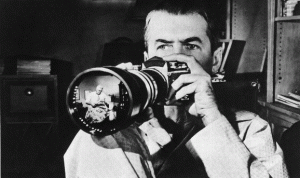Week 8: Psychoanalysis in film, feminism and cultural reading
December 19, 2010 Leave a comment
In week 8 we looked at Psychoanalysis in film, Feminism and cultural reading. The Gaze
The Bond Gaze
In Laura Mulvey’s article “Visual Pleasure and Narrative Cinema” she discusses the concepts of Freudian philosophy in accordance with filmmaking and the male gaze. However gender specific this analysis may be, Mulvey’s criticism can be applied to the homosexual gaze as well. “As the spectator identifies with the main male protagonist, he projects his look onto that of his like, his screen surrogate, so that the power of the male protagonist as he controls events coincides with the active power of the erotic look…” (Mulvey 20) http://www.angelfire.com/film/articles/bond.htm
What is the Gaze, The concept of gaze is one that deals with how an audience views the people presented. For example For feminists it can be thought of in 3 ways (How men look at women, How women look at themselves, How women look at other women. etc)
Psychoanalysis + Cinema + Photography
reading Reference – Reading Images by Ros coward the luole
Spectatorship, of the power of the gaze
A list of gaze’s
Male Gaze – diagetic (within the film)
C.Metz – The imaginary (as in imaged) signifier
“Projection apparatus theory – Passive Spectator, Apparatus theory, derived in part from Marxist film theory, semiotics, and psychoanalysis, was a dominant theory within cinema studies during the 1970s. It maintains that cinema is by nature ideological because its mechanics of representation are ideological. Its mechanics of representation include the camera and editing. The central position of the spectator within the perspective of the composition is also ideological. Apparatus theory also argues that cinema maintains the dominant ideology of the culture within the viewer. Ideology is not imposed on cinema, but is part of its nature. Apparatus theory follows an institutional model of spectatorship.
J.lacan, Child development identification, Mirror stage formation of ego:
“The socalled “Mirror Stage” (“Stade du Miroir” by J. Lacan) seems to be a normal stage of development between the sixth and the eighteenth month of age. In the centre of this study you find terms of developmental psychology and especially of psychoanalysis like: ‘mother-child relationship’, ‘first relationship to objects’, ‘passage from primary to secondary narcism’, ‘ego-ideal’ and ‘ideal of the ego’ and others. The Mirror Stage seems to be especially important for the formation of the identity: wether the child becomes ‘normal’, ‘neurotic’ or ‘psychotic’. Here we also find terms, invented by Lacan like the ‘Real’, the ‘Imaginary’ and the ‘Symbolic’.” (by Gruber J, lines 1-3, http://www.ncbi.nlm.nih.gov/pubmed/543322)
the theory of the mirror stage is regarded as the cornerstone of Lacan’s oeuvre. as an image seen, m is identification. The mirror phase was defined in 1936 by Jaques Lacan, a post-Freudian psychoanalyst, who explained how the imaginary misrecognition ‘situates the agency of the ego, before its social determination, in a fictional direction.
“At some time between six and eighteen months, the baby sees its image, generally in a mirror, and realises that what it is seeing is somehow itself. This recognition causes great confusion and ‘libidinal dynamism’ (Lacan, 1977) as the pre-linguistic infant struggles with its first identity conflict.” (http://www.changingminds.mobi/disciplines/psychoanalysis/concepts/mirror_phase.htm, (Lines 1-2)
E.g. Alfred Hitchcocks – Rear window
Laura mulvey and the male gaze – maybe she has a point.
That sometimes we go to the cinema to escape our everyday woe’s, the notion of the gaze. how we try to read it (psychoanlytic, Freudian psychoanalysis)
#Zizek – the elvis of cultural theory psychoanlytic cultural academic#
Film reference – Tomb raider:
In both movies, Tomb Raider and Tomb Raider 2: The Cradle of Life a scene is shown that depicts Ms. Croft absolutely nude, which doesn’t even begin to cover the multitude of scenes in which she is dressed in relatively scanty clothing, clothing completely inappropriate to the situations in which she finds herself (rappelling down cliffs, raiding an ancient Cambodian temple, fending off sharks and other marauders in an underwater Grecian temple), clothes that none of the male explorers would possibly even consider subjecting themselves to. How, pray tell, are Daisy Duke short-shorts practical gear for an intrepid adventurer? Or an ultra-thin skin-tight wetsuit? Or even her impractically long, but oh-so cinematic river of hair, that we are shown more than once is easily grabbed by villains in fight scenes, to be used against her? Wouldn’t it make more sense for Ms. Croft to cut her hair, tape down her boobs (which are majestic in the way that the worlds largest ball of twine is – aesthetically a feat of engineering, yet ultimately functionless), and wear clothes that cover her skin when she’s going into a knife-fight.
female audience members, she presents a standard to live up to, even one as impossible as the feat of trying to emulate someone like Angelina Jolie. A girl, watching this new action heroine, gets the message “It’s okay to kick ass, honey, just so long as you take care to jiggle.” The actresses playing these women are the cream of Hollywood, some of the most impossibly beautiful women in the world, with armies of personal trainers and stunt choreographers and costuming and makeup departments backing them. A girl can emulate these movie icons, but she can never (at least not in normal life) really come close to attaining anything like their image (or, to be fair, their adventures- unless it is revealed tomorrow that mutants, superpowers, and ancient curses walk among us). taken from http://everything2.com/title/Girls+Kick+Ass%253A+A+Feminist+Critique+of+the+New+Action+Heroine+and+the+Male+Gaze (paragraph 10)



